
The fossils of Mendip
Silurian | Upper Devonian | Lower Carboniferous | Triassic | Lower to Middle Jurassic
Lower to Middle Jurassic fossils (200 to 161 million years ago)
Lias Group
The Lias Group of the Mendips formed in relatively shallow water conditions adjacent to emergent parts of the Mendip massif. Consequently the fossil faunas are not always so diverse as in the better-known Lias succession of Dorset and north Somerset. Bivalves such as Gryphaea, Pseudolimea, Plagiostoma, Pinna, Placunopsis, Oxytoma and Liostrea are relatively common, and large gastropods such as Pleurotomaria, also occur. The brachiopods Lobothyris and Spiriferina have been collected from the Lias Group at Evercreech, with belemnites and crinoids. Ammonites are rather rare, although large specimens of Arietites bucklandi have been found near Shepton Mallet and Caloceras is relatively common in the succession at Milton, near Wells.
The rare remains of the primitive mammal-like reptile Oligokyphus have been found infilling fissures in the Carboniferous Limestone near Shepton Mallet. The remains appear to occur in Lower Jurassic sediments, and are thought originally to have accumulated around springs on the Mendip islands, before being swept into the sea by flooded rivers and entering the open fissures on the sea bed.
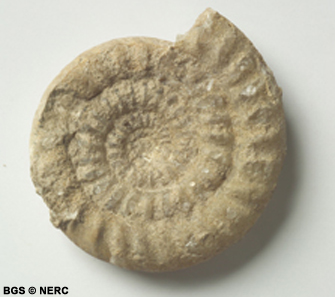
Downside Stone (Lias Group)
The richly fossiliferous Downside Stone contains the broken-up remains of bivalves (including coarse-ribbed forms), analagous to modern-day shell banks, and suggests that this was a turbulent, shallow water, near-shore setting. Common bivalves include Cercomya, Ctenostreon, Atreta, Liostrea, Plagiostoma, Pseudopecten and Terquemia. Fossils that are more typical of open-water environments are rare, but a few ammonites, such as Alsatites, Waehneroceras, Schlotheimia, Caloceras and Coroniceras have been found.
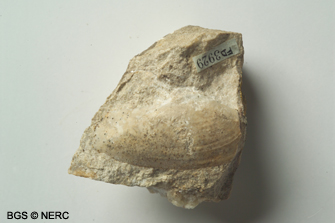
Inferior Oolite Formation
In the Mendips, only the younger, upper part of the Inferior Oolite is preserved, overlying a remarkably planar, oyster-encrusted erosion surface that cuts across the Carboniferous Limestone and has been bored in to by rock-dwelling bivalves such as Lithophaga. The surface, cut by marine erosion at a time of rising sea level, represents a rocky Middle Jurassic sea floor. At Vallis Vale, the limestones above the erosion surface contain a variety of bivalves (e.g. Pseudolimea, Pholadomya, Ctenostreon), brachiopods (e.g. Acanthothyris, Stiphrothyris) and echinoids (e.g. Clypeus, Pseudodiadema, Arcosalenia, Holectypus).
At Doulting, the fauna of the Inferior Oolite includes relatively common ammonites, such as Cadomites, Leptosphinctes and Orthogarantiana near the base, and Parkinsonia, Morphoceras, Oxycerites and Zigzagiceras near the top. A limestone succession at the top of the Inferior Oolite is named the Anabacia Limestone after the abundance of the small button coral Chomatoseris ('Anabacia') porpites.
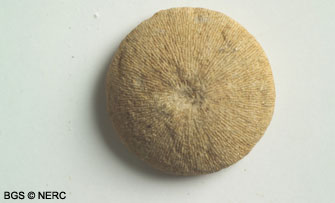
Great Oolite Group, Fuller's Earth Formation
The youngest Jurassic rocks of the Mendips, represented by the Fuller's Earth Formation, comprise an ammonite-rich limestone succession overlain by oyster-rich mudstones. The limestone is named the Fullonicus Limestone after the abundance of the ammonite Procerites fullonicus. The limestone also contains brachiopods (e.g. Acanthothyris), bivalves (e.g. Modiolus and rare Catinula) and gastropods. The mudstones above the Fullonicus Limestone are named the Knorri Beds, after their abundance of the oyster Catinula knorri.
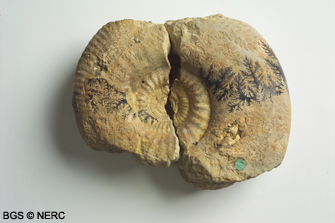
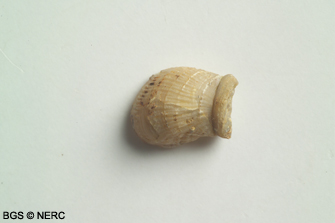
- Home
- Overview maps
- Locality
areas
- Cheddar Gorge
- Charterhouse
- Blackdown
- Burrington Combe
- Shipham & Rowberrow
- Crook Peak & Axbridge
- Banwell to Churchill
- Priddy
- Harptree & Smitham Hill
- Draycott & Westbury-sub-Mendip
- Wookey Hole & Ebbor Gorge
- Wells
- Great Elm & Vallis Vale
- Mells & the Wadbury Valley
- The Vobster area
- The Whatley area
- Torr Works & Asham Wood
- Beacon Hill
- Stoke St Michael & Oakhill
- Holwell & Nunney
- Shepton Mallet & Maesbury
- Gurney Slade & Emborough
- The Nettlebridge valley
- Geology
- Minerals and mines
- Quarrying
- Caves and karst
- Biodiversity
- Detailed site information
- Acknowledgements
- External links
- Search
- Site map